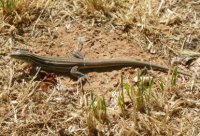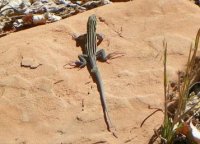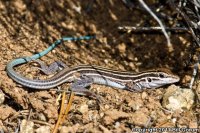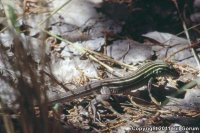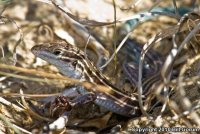| Range: |
 |
| Other Names: |
|
| Description: |
A small (up to 85 mm or 3.3" from snout to vent), slim, dark brown to black lizard with a long, thin tail, and a slim, pointed snout. The body is marked with six or seven yellow to cream stripes. When present the (seventh) mid-dorsal stripe is thin and muted or discontinuous. The tail is light blue. The underside is plain and pale. Juveniles have a bright blue tail. The scales on the body are small and granular. The scales on the tail are large, keeled, and rectangular. The belly scales are large, smooth, and rectangular. The scales on top of the head are large, smooth, and plate-like. |
| Similar Species: |
Its lack of spots distinguishes this lizard from many whiptails. Its distinctly blue tail coloration distinguishes it from the similar looking Desert Grassland Whiptail. |
| Venom: |
None |
| Habitat: |
A wide variety of communities are inhabited including Great Basin Desertscrub, Plains and Great Basin Grassland, Great Basin Conifer Woodland, and Petran Montane Conifer Forest. Found in an equally wide variety of terrain types including open flatlands, riparian corridors, bajadas, wooded foothills, canyons, and slopes.
|
| Behavior: |
This is an alert, diurnal, fast-moving ground-dweller. It is an extremely active lizard that spends nearly all of its waking hours in motion foraging and moving between sun and shade for thermoregulation. |
| Hibernation: |
It hibernates during the cold months of fall and winter. |
| Reproduction: |
All Plateau Striped Whiptails are female (parthenogenetic). Eggs are unfertilized and hatchlings are clones of the mother. Three to 5 eggs are laid in June or July. Hatchlings begin to appear in August. |
| Diet: |
This lizard actively forages by rooting around in organic matter under bushes and by digging in the soil around the bases of rocks, logs, and other surface debris. It has also been observed to forage in low shrubs off the ground. It feeds on a variety of insects and spiders. |
Adapted from account on reptilesofaz.org
Sources:


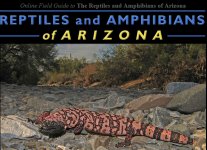
|



